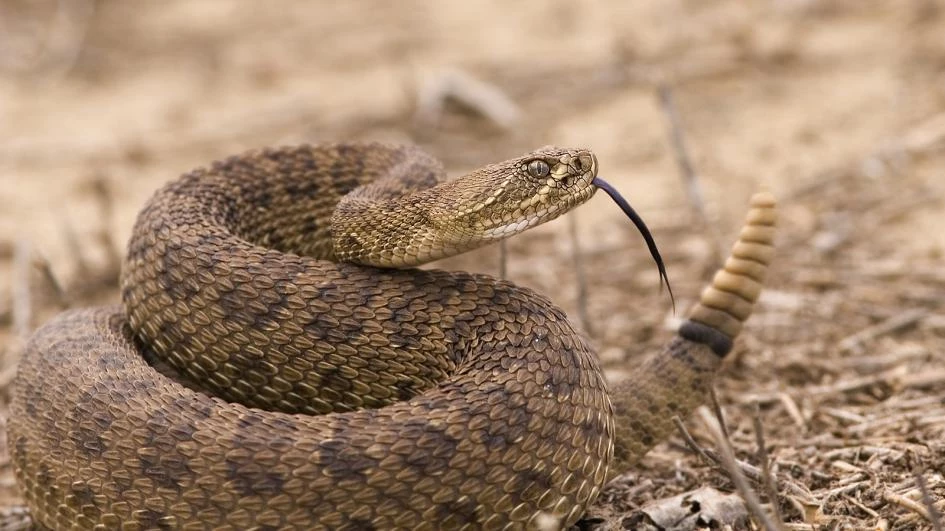What to do if a rattlesnake bites?
Erik C. | May 23, 2019, Updated: Jun 5, 2019 | 3 min read

A Majority of rattlesnake bite victims survive, whether it be a dog, cat, or human, because they seek immediate medical attention. Most dogs are usually bitten on the nose and face because they want to sniff the snake, while cats are bitten on the paw because they want to swat at the snake. A bite is particularly serious if the dog or cat has been bitten in the eye, mouth, or ear area because the concentration of blood vessels. Being bitten in the chest is also very serious because of the proximity to the heart and other vital organs.
Rattlesnakes have a distinctive triangular shape to their heads with a noticeable neck.
They also have vertical pupils, whereas non-poisonous snakes have round pupils and a more streamline design between their head and body. With this said, if you or your pet gets bitten by a snake, don’t try to identify it, allow it to get away! Snakes will strike again and again, which will make the situation worse if the snake id indeed poisonous. When in doubt, seek medical attention quickly. If the bite was from a poisonous snake, swelling will be fast and considerable. Remove anything from your animal that is close to the bite that will restrict circulation, like a collar or bandanna. (This including rings, bracelets, watches, clothing, and shoes for humans.)
Rattle snakes can strike so fast that their movement is indiscernible to the human eye. A rattle snake does not need to be coiled to strike. They can strike in any position, but if given enough of a warning they will coil, because this posture gives them the best striking distance. Often rattlesnakes strike first and rattle after, so do not rely on hearing them. Rattlesnakes are deaf, so if you hike, carry a stick and use it to announce your path by tapping it on the ground and king it ahead of your overgrown areas. Rattlesnakes are sensitive to vibrations and will get out of your way if you give them enough warning.
Twenty-five percent of rattlesnake bites are dry, meaning they release no venom, but it is still prudent to seek medical attention. Do not consider baby rattlesnakes less of a threat. Baby rattlesnakes can release more venom than an adult because controlling the amount of venom they release is a skill they develop over time.
Your veterinarian may want to give your dog or cat Antivenin. It is very important to tell your veterinarian if the dog has received Antivenin before. A second dose of Antivenin carries a higher mortality rate than the snakes bite. Antivenin is expensive and should be sued in the most severe cases. Your pet will be put on intravenous Fluids and Perhaps Anti-histamines.
Fore-warned is forearmed. The best plan is to avoid snake bites all together by giving any snake the right of way. Keep your dog by your side when hiking and carry a staff for accounting you path ahead of you. Rattlesnake bites are serious, but 95% of pets survive. In fact, some hard headed dos get bit several times a season because they cannot learn to leave the snakes alone. There is vaccination against bites, but it is limited because it is so new. Do not assume that no rattlesnakes live in your area, habitats change because of land development and fluctuations in rodent populations. Be aware and be safe.
What do if your dog gets bitten by a rattle snake:
– Get everyone away from the snake. It is difficult to identify a snake unless you are an expert. It is not necessary to know what kind of rattlesnake caused the bite.
– Get medical help IMMEDIATELY. Animals with the highest mortality rate are small breed dogs and dogs who did not get medical attention right away. Call your vet en route, so the staff is prepared for you. (most hospitals don’t carry or have a very small amount of antivenin available for emergencies)
– Keep pet calm. If possible, carry the animal. The more activity, the more blood circulation, the fast the toxin will spread through the body.
– DO NOT CUT INTO THE BITE.
– DO NOT TRY TO SUCK OUT THE VENOM.
– DO NOT APPLY ICE. (Despite your reface to treat the swelling, ice will aggravate the problem.)
– DO NOT APPLY HEAT.
– DO NOT APPLY A TOURNIQUET.
– DO NOT GIVE THE ANIMAL ANY MEDICATION.
#Hiking #Rattlesnakes
